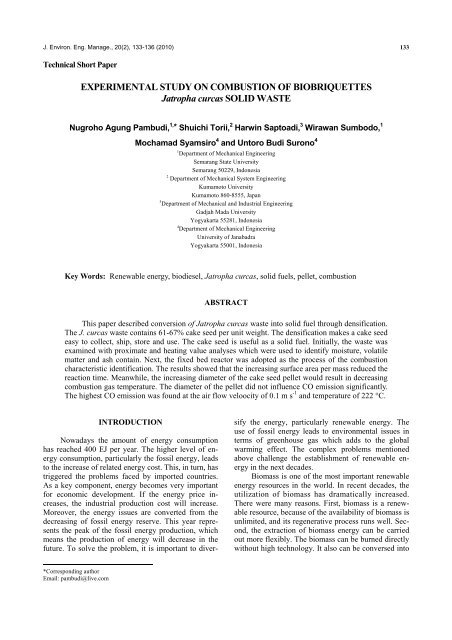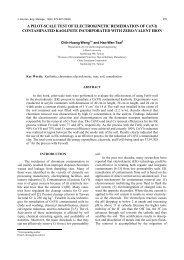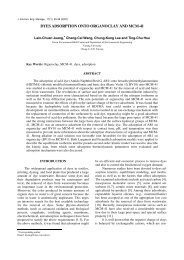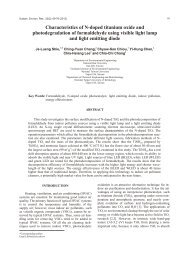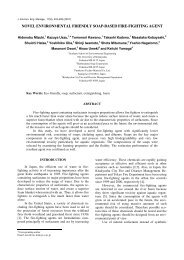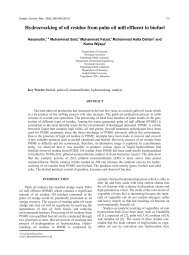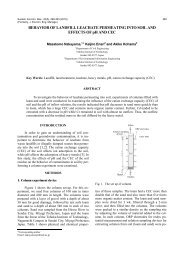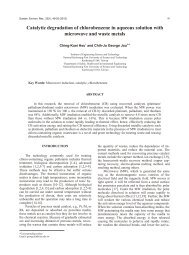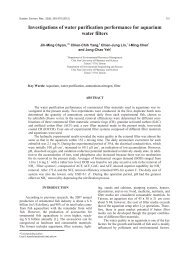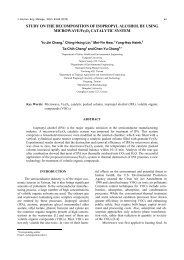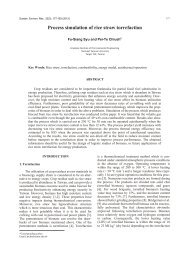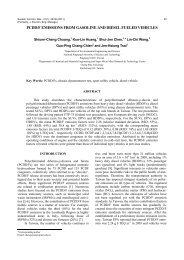EXPERIMENTAL STUDY ON COMBUSTION OF ... - SER
EXPERIMENTAL STUDY ON COMBUSTION OF ... - SER
EXPERIMENTAL STUDY ON COMBUSTION OF ... - SER
Create successful ePaper yourself
Turn your PDF publications into a flip-book with our unique Google optimized e-Paper software.
J. Environ. Eng. Manage., 20(2), 133-136 (2010) 133Technical Short Paper<strong>EXPERIMENTAL</strong> <strong>STUDY</strong> <strong>ON</strong> COMBUSTI<strong>ON</strong> <strong>OF</strong> BIOBRIQUETTESJatropha curcas SOLID WASTENugroho Agung Pambudi, 1, * Shuichi Torii, 2 Harwin Saptoadi, 3 Wirawan Sumbodo, 1Mochamad Syamsiro 4 and Untoro Budi Surono 41 Department of Mechanical EngineeringSemarang State UniversitySemarang 50229, Indonesia2 Department of Mechanical System EngineeringKumamoto UniversityKumamoto 860-8555, Japan3 Department of Mechanical and Industrial EngineeringGadjah Mada UniversityYogyakarta 55281, Indonesia4 Department of Mechanical EngineeringUniversity of JanabadraYogyakarta 55001, IndonesiaKey Words: Renewable energy, biodiesel, Jatropha curcas, solid fuels, pellet, combustionABSTRACTThis paper described conversion of Jatropha curcas waste into solid fuel through densification.The J. curcas waste contains 61-67% cake seed per unit weight. The densification makes a cake seedeasy to collect, ship, store and use. The cake seed is useful as a solid fuel. Initially, the waste wasexamined with proximate and heating value analyses which were used to identify moisture, volatilematter and ash contain. Next, the fixed bed reactor was adopted as the process of the combustioncharacteristic identification. The results showed that the increasing surface area per mass reduced thereaction time. Meanwhile, the increasing diameter of the cake seed pellet would result in decreasingcombustion gas temperature. The diameter of the pellet did not influence CO emission significantly.The highest CO emission was found at the air flow veloocity of 0.1 m s -1 and temperature of 222 °C.INTRODUCTI<strong>ON</strong>Nowadays the amount of energy consumptionhas reached 400 EJ per year. The higher level of energyconsumption, particularly the fossil energy, leadsto the increase of related energy cost. This, in turn, hastriggered the problems faced by imported countries.As a key component, energy becomes very importantfor economic development. If the energy price increases,the industrial production cost will increase.Moreover, the energy issues are converted from thedecreasing of fossil energy reserve. This year representsthe peak of the fossil energy production, whichmeans the production of energy will decrease in thefuture. To solve the problem, it is important to diversifythe energy, particularly renewable energy. Theuse of fossil energy leads to environmental issues interms of greenhouse gas which adds to the globalwarming effect. The complex problems mentionedabove challenge the establishment of renewable energyin the next decades.Biomass is one of the most important renewableenergy resources in the world. In recent decades, theutilization of biomass has dramatically increased.There were many reasons. First, biomass is a renewableresource, because of the availability of biomass isunlimited, and its regenerative process runs well. Second,the extraction of biomass energy can be carriedout more flexibly. The biomass can be burned directlywithout high technology. It also can be conversed into*Corresponding authorEmail: pambudi@live.com
134 J. Environ. Eng. Manage., 20(2), 133-136 (2010)Table 1. Proximate and heating value analysesProximate analysisMoisture (%)1.43Volatile (%)66.6Ash (%)4.6Fixed carbon (%)27.5Heating valueHigher heating value (MJ kg -1 ) 17.2Fig. 1. Jatropha curcas fruit.gas or liquid [1]. Biomass energy is more environment-friendlycompared with the fossil fuel. Theemission of CO 2 released from biomass into atmosphereis absorbed through a photosynthesis process. Itis called the carbon neutral. If this is the case, the excessiveaccumulation of carbon dioxide in atmospherewill not occur.Several countries, such as Indonesia, have begunto increase the development of Jatropha curcas (Fig. 1)as an energy plant to reduce the dependence on the fossilfuel. As reported by the National Indonesian Biofuelteam [2], Indonesia will provide the areas of 1.5million ha for J. curcas plant in 2010. Then, in 2015the area will reach 3 million ha. The cultivation of J.curcas as a plant for energy in Indonesia was supportedby the fact that the J. curcas is a plant that cangrow in marginal soils. It does not compete with otherfood plants.Several other countries also developed J. curcas,like Mexico, Thailand [3], Nicaragua [4], and India[5]. Most studies focused on the conversion from J.curcas into biodiesel [5-8], while several literaturesreported about Jatropha solid waste such as cakeseeds (seed husk), sludge, shells like activated carbon[9], seed husk open core gasification [10], the fixedbed pyrolisis of physical nut waste [11], and J. curcaspart for energy [12]. The cake seeds of J. curcas werethe waste resulted from the development of crude Jatrophaoil into a solid fuel. As reported by many authors[3,7,11], the content of cake seeds of J. curcasreached 61-67% per unit weight. The potential makesthe cake seeds the domestic cooking fuel or the energyfor biodiesel industry. The objective of this work wasto determine combustion characteristics from cakeseed J. curcas briquettes. Moreover, pyrolysis anddensification were studied.seeds with mesh size 30-40. Next, the proximate andheating value analyses of cake seeds were performed(Table 1).The cake seeds powder was mixed with starchbinder for pellet making. The binder ratio was 70%water and 30% cassava starch. While the ratio ofbinder with cake seeds powder was 10% binder and90% cake seed powder per unit weight. It meant thatthe binder role might be ignored because the ratio wasvery small. The mixing was performed in the homogeneousmaterial and a pellet was formed through thedensification process1. Palletizing ProcessA local press machine was used for the densificationwith the applied pressure of 1.55 MPa. Pelletwas made from Jatropha curcas waste of 1.5 g. Thediameter varied from 11 to 16 mm with the briquettelength of 6.5 to 15 mm (Fig. 2).The schematic of the combustion apparatus isshown in Fig. 3. It consisted of an air fan (1); a valve(2) to control the air flow rate; a gas heater (3); a preheatchamber (4) to provide the desirable temperaturein the fixed bed combustion chamber (5); a computer(9) and weight balance (10) to analyze the mass reductionfrom a single pellet. Pellet cup was connected tothe weight balance and the mass of a single pellet wasmeasured every minute. Then, the data would be sentto the computer. Digital thermocouples (7, 8) measuredgas temperature while the gas analyzer (6) measuredCO emission.METHODS AND MATERIALSCake seeds were collected from the local biodieselfactory. Originally, the form of cake seeds washeterogeneous as the result of press machine destruction.Sieve was used to establish homogeneity of cakeFig. 2. Pellet diameter.
Pambudi et al.: Solid Waste Conversion in FBR 135150Time (minutes)1282726252421. Air fan2. Control valve3. Gas heater4. Preheat chamber5. Combustion chamber6. Gas analyser7. Thermocouple8. Digital termocouple reader9. Computer10. Weight balance25.00220843 328.00220Reaction timeTemperature26.33219D = 11 mm D = 13 mm D = 16Diameter pelletFig. 4. Reaction time and temperature of pellet underdifferent diameter.711 10Fig. 3. Combustion equipment scheme.2. Experimental ProcedureThe purpose of the study was to see the effect of pelletdiameter and air flow rates on combustion temperatureand outlet CO concentration. Initially, thefixed bed combustion was cleaned to remove the oldash. Then, the combustion chamber was heated withtemperature of 400 °C and air velocity of 2 m s -1 . Next,the cake seed pellet was put inside the cup place in thecombustion chamber with the measurements of massreduction and outlet CO concentration as describedabove.RESULTS AND DISCUSSI<strong>ON</strong>1. Influence of DimensionThe reaction time is used to measure the performanceof pellet under combustion chamber. Figure 4shows the reaction time and temperature as a functionof pellet diameter. It can be seen that the diameter of13 mm had the longest reaction time of 28 min. Whilethe reaction time periods for pellets with 11 and 16mm diameters were 25 and 26 min, respectively. Thiswas caused by the surface area per mass. The pelletswith 13 mm diameter had the lowest surface area permass (395 mm 2 g -1 ) while the values were 472 and592212202192186Temperature ( oC)Time (min)CO (ppm)403020100120906030034.6722128.522026.3321925.17217v = 0.1 v = 0.2 v = 0.3 v = 0.4Air flow rates (m s-1) s )D = 11D = 13D = 160 5 10 15 20 25Time (min)Fig. 5. The emission of CO versus time with differentdiameters using air flow rate 0.2 m s -1 .469 mm 2 g -1 for pellets with 11 and 16 mm diameter,respectively. Meanwhile, the diameter pellet providesno such influence through the temperature of thecombustion. As shown in Fig. 5, the 1 st 5 min was fordrying when the moisture was released. Devolatilizationoccurs from the first 5 to 8 min with the sharp increasein CO emission. The process released the volatilematters as well as other combustible gases such asH 2 , CH 4 and CO.2. Effect of Air Flow RatesFigure 6 shows the gas temperature under thedifferent air flow rates. It can be seen that the increasingair flow rate decreased the gas temperature in thecombustion chamber. Although higher air flow ratesstrengthened the heat transfer in the combustionchamber, it carried high energy waste while leavingthe combustion chamber. It could be also observedthat the increasing of the air flow rates decreased reactionof time (Fig. 6).Figure 7 shows the effect of air flow velocity onCO emissions. The air flow rates had significant effecton devolatilization process. The highest CO emissionoccurred at the air flow velocity of 0.1 m s -1 , with thelowest CO emission at air flow velocity of 0.2 m s -1 .The high CO concentration was caused by the lowFig. 6. Reaction time and temperature of pellet underdifferent air flow rates.224222220218216214Temperature (°C) (? C)


